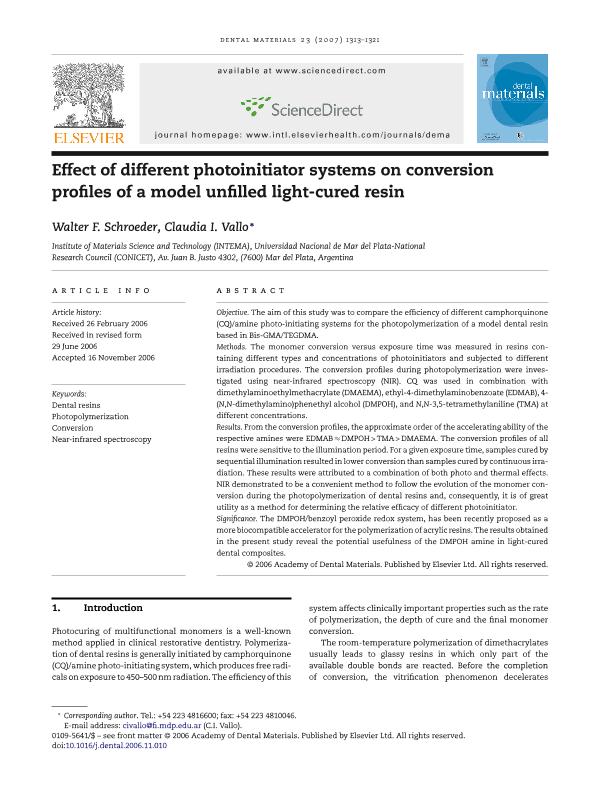Artículo
Effect of different photoinitiator systems on conversion profiles of a model unfilled light-cured resin
Fecha de publicación:
10/2007
Editorial:
Elsevier
Revista:
Dental Materials
ISSN:
0109-5641
Idioma:
Inglés
Tipo de recurso:
Artículo publicado
Clasificación temática:
Resumen
Objective: The aim of this study was to compare the efficiency of different camphorquinone (CQ)/amine photo-initiating systems for the photopolymerization of a model dental resin based in Bis-GMA/TEGDMA. Methods: The monomer conversion versus exposure time was measured in resins containing different types and concentrations of photoinitiators and subjected to different irradiation procedures. The conversion profiles during photopolymerization were investigated using near-infrared spectroscopy (NIR). CQ was used in combination with dimethylaminoethylmethacrylate (DMAEMA), ethyl-4-dimethylaminobenzoate (EDMAB), 4-(N,N-dimethylamino)phenethyl alcohol (DMPOH), and N,N-3,5-tetramethylaniline (TMA) at different concentrations. Results: From the conversion profiles, the approximate order of the accelerating ability of the respective amines were EDMAB ≈ DMPOH > TMA > DMAEMA. The conversion profiles of all resins were sensitive to the illumination period. For a given exposure time, samples cured by sequential illumination resulted in lower conversion than samples cured by continuous irradiation. These results were attributed to a combination of both photo and thermal effects. NIR demonstrated to be a convenient method to follow the evolution of the monomer conversion during the photopolymerization of dental resins and, consequently, it is of great utility as a method for determining the relative efficacy of different photoinitiator. Significance: The DMPOH/benzoyl peroxide redox system, has been recently proposed as a more biocompatible accelerator for the polymerization of acrylic resins. The results obtained in the present study reveal the potential usefulness of the DMPOH amine in light-cured dental composites.
Palabras clave:
Conversion
,
Dental Resins
,
Near-Infrared Spectroscopy
,
Photopolymerization
Archivos asociados
Licencia
Identificadores
Colecciones
Articulos(INTEMA)
Articulos de INST.DE INV.EN CIENCIA Y TECNOL.MATERIALES (I)
Articulos de INST.DE INV.EN CIENCIA Y TECNOL.MATERIALES (I)
Citación
Schroeder, Walter Fabian; Vallo, Claudia Ines; Effect of different photoinitiator systems on conversion profiles of a model unfilled light-cured resin; Elsevier; Dental Materials; 23; 10; 10-2007; 1313-1321
Compartir
Altmétricas




